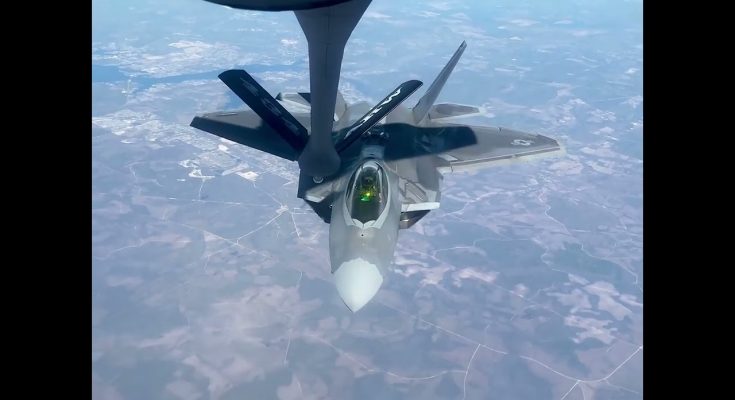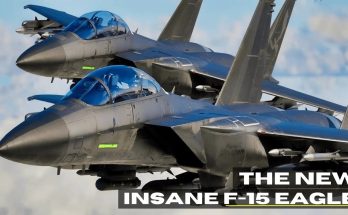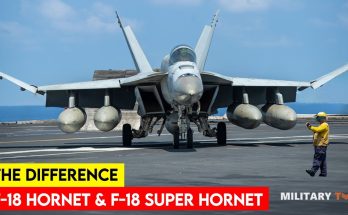Nervous Moments as F-22 Raptor Refuels: Look at the Pilot!
In the high-stakes world of military aviation, every second counts, especially when it comes to the delicate and crucial task of aerial refueling. The F-22 Raptor, the U.S. Air Force’s premier fifth-generation stealth fighter, is one of the most advanced aircraft in the world. But even this formidable machine relies on aerial refueling to extend its operational range and maintain its superiority in the sky. When it comes to refueling a fighter jet like the F-22, there are moments of tension, precision, and focus — especially for the pilot.
The Challenge of Refueling the F-22
The F-22 Raptor, with its unmatched agility and advanced stealth capabilities, is designed for air superiority. However, its fuel capacity is limited, which means it needs to refuel in-flight for long missions, especially during combat operations or extended sorties. Aerial refueling involves transferring fuel from a tanker aircraft, often a KC-135 or KC-10, to the fighter jet through a hose and drogue or a flying boom system. This process requires remarkable precision from both the tanker crew and the pilot of the F-22.
The pilot of the F-22 must position the aircraft with pinpoint accuracy to align with the refueling tanker’s fuel hose or boom. The maneuvering is made even more complex by the fact that both aircraft are flying at high speeds, often at altitudes of 20,000 feet or higher, and the space in which the F-22 must align is incredibly narrow.
The Pilot’s Nerve-Racking Task
For the F-22 pilot, the refueling process is often described as one of the most nerve-wracking moments in aviation. Despite the highly trained crew and sophisticated avionics in the F-22, the task of connecting to the tanker requires an intense level of focus, skill, and mental fortitude. The pilot must maintain steady control of the aircraft while adjusting to the tanker’s speed and movements.
The pilot’s cockpit is filled with an array of instruments and displays, but at that moment, nothing is more important than the refueling process itself. The moment of connection is tense — too much pressure, and the hose or boom could snap; too little, and the connection might not be made at all. As the refueling probe extends from the tanker, the pilot’s hands remain steady on the controls, while their eyes are fixed on the instruments and visual cues guiding them toward the fuel receptacle.
One of the most nerve-wracking aspects of aerial refueling is the timing. In some cases, a fighter jet like the F-22 will have a window of only a few minutes to top off its tanks. If anything goes wrong, it could mean the loss of precious fuel and, potentially, the loss of a mission or the need for an emergency landing.
Look at the Pilot!
The facial expressions of a pilot during such a moment can say it all — a mix of concentration, calm, and an underlying awareness of the stakes involved. The pilot must balance the need for precision with the pressure of maintaining a steady hand in the face of possible turbulence, changing air currents, and the ongoing motion of both aircraft.
In photographs and videos capturing these moments, you might see the pilot’s focus sharpened, their hands lightly gripping the controls as their gaze shifts from the fuel receptacle on the tanker to the instruments in front of them. Some pilots even show a slight grin or nod once the connection is made, as the tense moments subside and they can return to full power, knowing the mission is back on track.
While the pilot’s training prepares them for this, the reality of the task — with so much on the line, both for the aircraft and the mission — creates palpable tension in the cockpit. For an F-22 pilot, moments like these are the test of both skill and nerve. The visual cues from the refueling process, combined with the occasional turbulence or environmental challenges, make every refueling a high-wire act that requires both the physical and mental agility of a top-tier aviator.
The Importance of Refueling in Modern Combat
In modern aerial combat, the ability to refuel in-flight has become an essential component of operational success. Long-distance missions, strategic strikes, and persistent air patrols all depend on the ability to refuel without having to return to base. For a fighter like the F-22, this capability ensures that it can stay in the air longer, remain flexible, and strike decisively when and where it is needed.
Without the ability to refuel mid-air, the F-22’s operational radius would be severely limited, and its effectiveness in global conflict would diminish. Therefore, despite the nervous moments and tense maneuvers, aerial refueling remains an essential part of maintaining air dominance.
Conclusion
The sight of an F-22 Raptor refueling in mid-air is a testament to the advanced technology of modern military aviation and the skill of its pilots. Behind the impressive hardware is a human element — the pilot’s steady hands, sharp focus, and unflappable nerve. The tension is real, but the payoff is clear: a fighter jet that can go farther, stay longer, and accomplish more. And in the high-stakes world of air combat, that makes all the difference.



